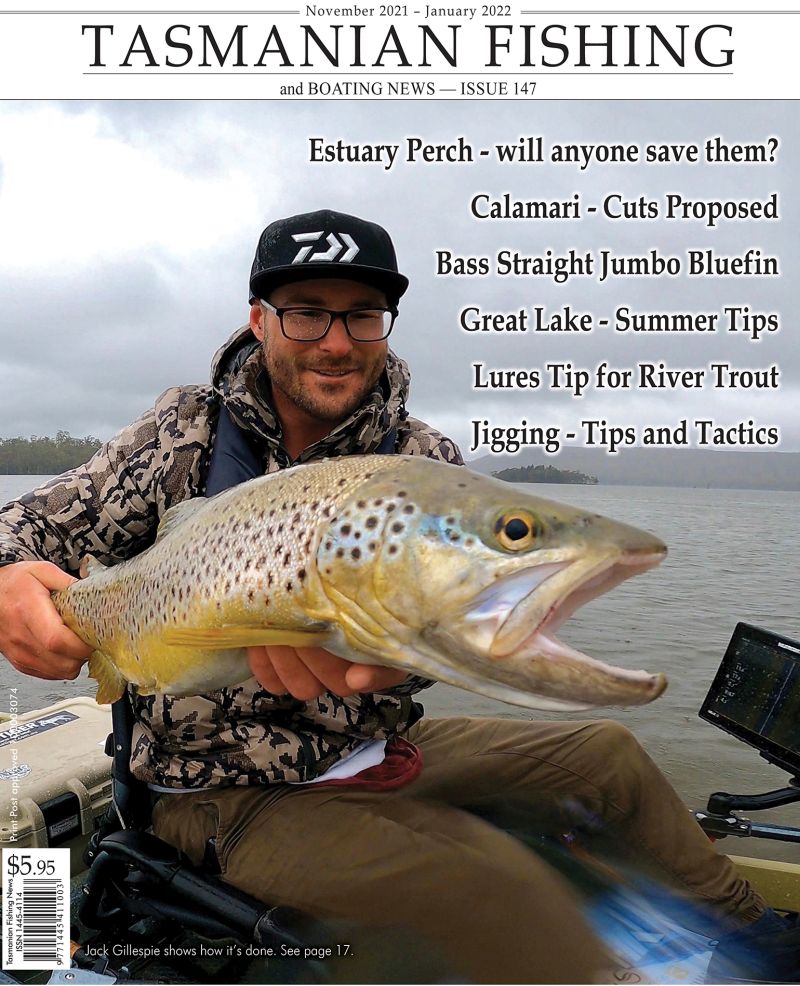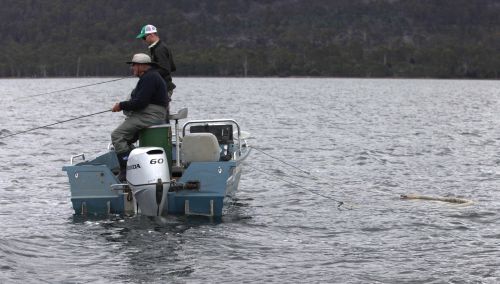Mike's Top 10 Spots
Tasmania's Top Ten Fishing Spots
All articles by Mike Stevens
Tasmania is surrounded by water and has some spectacular marine fishing from bays, river and estuary systems to game fishing for yellowfin tuna, albacore, striped marlin and southern bluefin tuna.
Southern bluefin tuna are one of the most keenly sought game fish and several world records for these are held in Tasmania.
In fresh water Tasmania has a world class trout fishery. The Central Highlands boasts over 3000 lakes and tarns, most of which hold trout. Many of these are only accessible by foot, but the journey can be a reward in itself as the walk can be spectacular. Rivers are also highly regarded and many have reasonable flows all year.
1 Tyenna River
The Tyenna, a tributary of the Derwent, starts at the back of Mount Field flowing in an easterly direction for some 40 kilometres before its confluence with the Derwent River above Bushy Park.
- Written by Stephen Smith - Rubicon Web and Technology Training
- Parent Category: Fishing Information
- Category: Mike's Top 10 Spots
- Hits: 13575
2 Derwent River
Piersons Point - Iron Pot mark the lower limit of the Derwent Estuary and the transition to Storm Bay and the Tasman Sea. A good boat ramp at Tinderbox services this area and you should be aware of a Marine Reserve here that runs between Tinderbox and Bruny Island. Please refer here for relevant information, access and restrictions. Outside this there is excellent fishing for sand and tiger flathead, Australian salmon, couta (barracouta), plus longfin pike and occasionally good runs of squid. Warehou usually appear in the summer - autumn period and are known locally as snotties, or snotty trevally.
- Written by Stephen Smith - Rubicon Web and Technology Training
- Parent Category: Fishing Information
- Category: Mike's Top 10 Spots
- Hits: 16446
3 Pirates Bay, Tasman Peninsula and Pedra Branca
The continental shelf is quite close to shore here, and with a vast topographic underwater terrain the game fishing can be nothing short of sensational. Very deep water is common close to shore and a lot of game fishers troll virtually along the bottom of the many spectacular cliffs in search of game fish. Water depths of over 100 metres are common close inshore.
- Written by Stephen Smith - Rubicon Web and Technology Training
- Parent Category: Fishing Information
- Category: Mike's Top 10 Spots
- Hits: 8874
Read more: Top 10 (03) Pirates Bay, Tasman Peninsula and Pedra Branca
4 St Helens
A great fishery all year round.
A few species that may be found include Australian salmon, flathead, garfish, albacore, yellowfin tuna, striped marlin and mako shark.
The township of St Helens is nestled on Georges Bay, a sheltered area of water situated a quarter of the way down Tasmania's East Coast. St Helens provides a large range of estuarine and offshore species. Relatively mild weather is experienced even over winter due to protection from the prevailing westerly winds. Five boat ramps service the area, three in Georges Bay, the other two giving direct ocean access via Binalong Bay and Burns Bay, eliminating the need to cross the St Helens barway.
- Written by Stephen Smith - Rubicon Web and Technology Training
- Parent Category: Fishing Information
- Category: Mike's Top 10 Spots
- Hits: 10860
5 East Coast Rivers
Although not a single location the east coast rivers of Tasmania offer perhaps the best bream fishing in Australia. From below Hobart to Musselroe all river have healthy populations of black bream (Acanthopagrus butcheri).
- Written by Stephen Smith - Rubicon Web and Technology Training
- Parent Category: Fishing Information
- Category: Mike's Top 10 Spots
- Hits: 7212
6 Arthurs Lake
This is Tasmania's premium stillwater trout fishery. Open from August until May it is open to all trout angling methods including bait, lure and fly fishing.
Access is easy and Arthurs is situated about one hour from Launceston and about 1½ from Devonport and Hobart.
There are three good boat ramps at Jonah Bay, Pumphouse Bay and the Dam wall. As the level only varies a couple of metres all ramps are usually easily used.
Arthurs only contains brown trout and the average weight would be a little under one kilogram. Fish to two kilograms are often caught and bigger specimens to five kilograms feature annually.
- Written by Stephen Smith - Rubicon Web and Technology Training
- Parent Category: Fishing Information
- Category: Mike's Top 10 Spots
- Hits: 8494
7 Four Springs Lake
Only twenty five minutes from Launceston is Four Springs Lake. This small, easily accessed lake was the dream of a group of anglers. The dream was to have a premium fishery in natural surroundings, close to Launceston, with a good head of large fish.
Everything that was desired was achieved and the confluence of four creeks was dammed in the 1990s and a new fishery was born.
- Written by Stephen Smith - Rubicon Web and Technology Training
- Parent Category: Fishing Information
- Category: Mike's Top 10 Spots
- Hits: 7155
8 Duck Bay - Smithton
A premium protected estuary situated on the Duck River at Smithton. Some years ago this bay was netted regularly, both commercially and recreationally. That is now in the past and the fishing has improved enormously. Australian salmon, flathead, silver trevally and big King George whiting are regulars on bait and lures, soft plastic lures being especially popular.
- Written by Stephen Smith - Rubicon Web and Technology Training
- Parent Category: Fishing Information
- Category: Mike's Top 10 Spots
- Hits: 13577
9 Lake Burbury
Situated about eight kilometres east of Queenstown on Tasmania's west coast is Lake Burbury. The lake is split by the Lyell Highway and overall it is about 20 kilometres long, but one would never be more than one kilometre from shore. This is a relatively new lake, being filled in 1992.
Predictions varied about how it would shape up due to copper pollution from the old Mount Lyell mine. Some said it would become barren and the trout would die, whilst other predicted a Lake Pedder experience of huge fish and then others claimed it would be over populated with small fish.
- Written by Stephen Smith - Rubicon Web and Technology Training
- Parent Category: Fishing Information
- Category: Mike's Top 10 Spots
- Hits: 7309
10 Best Inland waters by catch rate
The top ten most popular still water fisheries in 2011-12 (in descending order) were Arthurs Lake, Great Lake, Woods Lake, Little Pine Lagoon, Craigbourne Dam, Penstock Lagoon, Four Springs Lake, Lake Barrington, Bronte Lagoon and Bradys Lake. The most popular rivers were the River Derwent, South Esk, Brumbys Creek, Mersey River, Meander River, Macquarie River, River Leven, Tyenna River, Huon River, and St Patricks River.
- Written by Stephen Smith - Rubicon Web and Technology Training
- Parent Category: Fishing Information
- Category: Mike's Top 10 Spots
- Hits: 7445
Tasmania's Top Ten Fishing Spots
by Mike Stevens (The Complete List)
- Written by Stephen Smith - Rubicon Web and Technology Training
- Parent Category: Fishing Information
- Category: Mike's Top 10 Spots
- Hits: 10288
Current TFBN
Click above for current issue content. The current issue of TFBN is extensive and topical. In Tackle Stores, Newsagents and by subscription.
Delivered to your door for $48 for 2 years (8 issues). To subscribe, send Mike $48 via www.paypal.com.au . (Basic instructions are here) The email is at Contact Us. Your address will be included from PayPal.
Or phone Mike with your c/c handy on 0418129949
Please ensure your details are correct, for Mike to organise delivery.
TFBN Newsletter Sign up Form
Why not submit an article ?
When you have finished for the day, why not have a brag about the ones that didn't get away! Send Mike an article on your fishing (Click here for contact details), and we'll get it published here. Have fun fishing - tasfish.com
Category Descriptions
Here is a list of all of the Article Categories. The number in Brackets, eg (13) is the number of articles. Click on Derwent River and all articles relating to the Derwent will be displayed in the central area.
Articles by Category
-
Rivers (3)
-
Saltwater and Estuary Fishing (149)
-
Kayak Fishing (34)
-
Lakes (1)
-
Great Lake (62)
-
Lake Leake (52)
-
Woods Lake (16)
-
Lake Augusta (11)
-
Huntsman Lake (13)
-
Lake Pedder and Gordon (10)
-
Lake Dulverton (5)
-
Lake Crescent (6)
-
Tooms Lake (10)
-
Lake Mackintosh (2)
-
Lake Barrington (5)
-
Little Lake (8)
-
Meadowbank Lake (5)
-
Lake King William (7)
-
Lake St Clair (2)
-
Western Lakes (12)
-
Arthurs Lake (35)
-
Lake Echo (7)
-
Four Springs (54)
-
Lake Sorell (7)
-
Lake Burbury (6)
-
Other Lakes (57)
-
Brushy Lagoon (18)
-
Little Pine Lagoon (5)
-
Penstock Lagoon (16)
-
Brumbys Creek (7)
-
-
Events (48)
-
Estuary Fishing (0)
-
Coastal Catches (46)
-
Super Trawler (46)
-
IFS, DPIPWE, MAST and Peak Bodies (435)
-
Commercial Interests (98)
-
Other (24)
-
TFBN Back Issues (8)
-
Fly Fishing (67)
-
Trout Fishing (252)
-
Meteorology and Weather (8)
-
Jan’s Flies (50)
-
Tuna Fishing and other Game Fishing (86)
-
Cooking Fish (19)
-
Fishing Information (1)
-
Fishing Books (8)
-
Videos (5)
-
Tackle, Boats and other Equipment (146)
-
World Fly Fishing Championship 2019 (2)
Popular Tags
windyty.com
Visit https://www.windyty.com/
Rubicon Web and Technology Training
Hello everyone, I thought it would be a good time to introduce myself.
My name is Stephen Smith and I have been managing the website tasfish.com since May 2009.
It has been an epic journey of learning and discovery and I am indebted to Mike Stevens for his help, support and patience.
I am developing a new venture Rubicon Web and Technology Training ( www.rwtt.com.au ). The focus is two part, to develop websites for individuals and small business and to train people to effectively use technology in their everyday lives.
Please contact me via www.rwtt.com.au/contact-me/ for further information - Stephen Smith.
From the Archives ... (last chance)
Atlantic salmon the hard way
Atlantic salmon the hard way
Scott McDonald
The first Atlantic salmon eggs used to begin Tasmania's Atlantic salmon aquaculture industry were introduced into Tasmania in 1984. From these humble beginnings a valuable Tasmanian industry has evolved with a worldwide reputation for having a premium disease free product. This industry provides a spin off to all anglers in the form of regular escapes of salmon from the farms.



